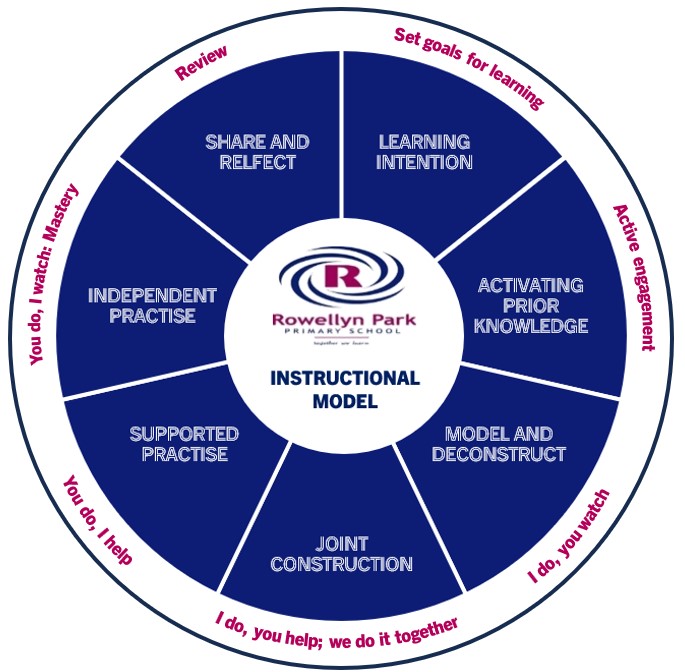
- The gradual release of responsibility model of instruction suggests that cognitive work should shift slowly and intentionally from teacher modelling, to joint responsibility between teachers and students, to independent practise and application by the learner.
- At Rowellyn Park, teachers may choose to begin in any part of the framework. Students move back and forth between each of the components as they master skills, strategies, and standards.
WHAT DOES EACH COMPONENT OF THE MODEL INVOLVE?
| Model Component: | Purpose/Description: |
| Learning Intention Set Goals for Learning | Learning Intentions are descriptions of what learners should know, understand and be able to do by the end of a learning period or unit. Learning intentions are the basis for tracking student progress, providing feedback and assessing achievement. |
| Activating Prior Knowledge Active Engagement | The teacher builds students’ knowledge of the field by explicitly teaching the language associated with the learning. This includes both ‘social’ and ‘academic’ language. The teacher will lead students to revisit required understandings or use this component of the model for spacing and retrieval practise. |
| Model and Deconstruct I do, you watch | The teacher provides and deconstructs models and/or graphic organisers to represent the language, thinking and organisation of strategies. The teacher uses ‘think aloud’ to explicitly model the strategies and language used when deconstructing model. Use worked examples explicit teaching strategies. |
| Joint Construction I do, you help; We do it together | The teacher models the thinking and organisation strategies that are required to demonstrate the knowledge/skill. The teacher or co-educator provides corrective feedback, check for understanding and address misconceptions. Students engage in collaborative learning and peer-based support. |
| Supported Practise You do, I help | The teacher and/or co-educator listens to how students talk about the task, watch how they work and probe into their thinking using prompts. The use of effective questioning supports students to think deeply about their performance and apply the feedback to demonstrate the success criteria. Teachers provide differentiation by enabling or extending student engagement. |
| Independent Practise You do, I watch: Mastery | Students action any feedback independently and build confidence and fluency in relation to the intended learning. |
| Share and Reflect Review | This is where the teacher encourages and facilitates the reviewing and assessing of success in relation to the intended learning. Students engage in metacognition and peer feedback at times. |
